A Basic Guide to CNC Lathe Machines
A Basic Guide to CNC Lathe Machines
1. CNC Lathe
CNC Turning or CNC Lathing is a manufacturing process in which bars of material are held in a chuck and rotated while a tool is fed to the piece to remove material to create the desired shape. A turret (shown center), with tooling attached is programmed to move to the bar of raw material and remove material to create the programmed result. This is also called “subtraction machining” since it involves material removal. If the center has both tuning and milling capabilities, such as the one above, the rotation can be stopped to allow for milling out of other shapes.
CNC turning refers to the automated machining process of shaping material, such as metal, wood or plastic, using a computer numeric control (CNC) machine. In contrast to traditional turning utilizing a lathe, which usually requires continuous operator attention, CNC turning allows for multiple cutting actions to be completed under computer control.
CNC turning machines are able to provide low cost parts for simple cylindrical geometries. Live tooling is available for more complex geometries and is assessed on a case by case basis.
- The starting material, though usual round, can be other shapes such as squares or hexagons.
- Depending on the bar feeder, the bar length can vary. This affects how much handling is required for volume jobs.
- CNC lathes or turning centers have tooling mounted on a turret which is computer-controlled. The more tools that that the turret can hold, the more options are available for complexities on the part.
- CNC’s with “live” tooling options, can stop the bar rotation and add additional features such as drilled holes, slots and milled surfaces.
- Some CNC turning centers have one spindle, allowing work to be done all from one side, while other turning centers, such as the one shown above, have two spindles, a main and sub-spindle. A part can be partially machined on the main spindle, moved to the sub-spindle and have additional work done to the other side this configuration.
- There are many different kinds of CNC turning centers with various types of tooling options, spindle options, outer diameter limitations as well as power and speed capabilities that affect the types of parts that can be economically made on it.
2. CNC Lathes vs. Turning Centers
CNC lathe just strictly does turning; it’s a 2-axis lathe with X and Z axes and A CNC turning center has milling capability, or a second spindle plus milling capability, and so it might have a Y-axis as well. We also call those Multi-Tasking Machines. Most people called it a lathe in the past, but as CNC became more elaborate and with the addition of milling and sub-spindles, it evolved into a CNC turning center.
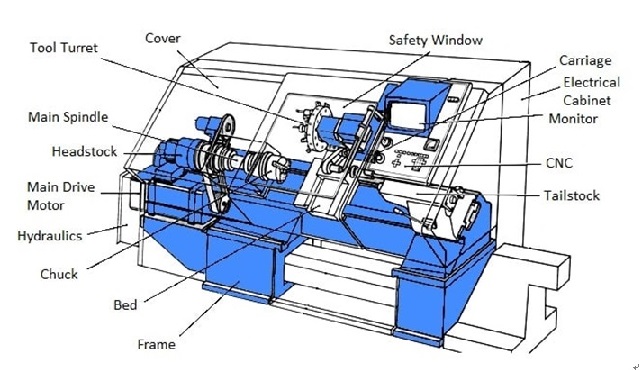
(1) Headstock
The headstock houses the main spindle as well as the speed- and gear-changing mechanisms. The main spindle end often includes a Morse taper. In the early days of industrial lathes, the spindle was driven directly via a flat belt pulley. These days, it’s driven by an electric motor.
(2) Bed
The lathe bed is a base connected to the headstock such that the carriage and tailstock move in parallel with the spindle access. This movement is facilitated by bedways, which restrain the carriage and tailstock in a set track.
(3) Feedscrews and Leadscrews
The feedscrew is a long driveshaft that connects to a series of gears in the apron in order to drive the carriage along the Z-axis. The leadscrew has the same function but operates orthogonally to the feedscrew, moving the carriage along the X-axis.
Feedscrews and leadscrews are manufactured to either imperial or metric standards, which can cause compatibility issues between workpieces made on different lathes.
(4) Carriage
The carriage holds the cutting tool and moves it longitudinally to the workpiece for turning operations or perpendicularly for facing operations. The carriage is composed of two castings: the top, or saddle, and the side, or apron.
(5) Tailstock
The tailstock refers to the center mount which is positioned opposite to the headstock. In contrast to the headstock, the spindle in the tailstock—which can include a taper to hold drill bits, centers or other tooling—does not rotate. Instead, it travels longitudinally under the action of a leadscrew.
3. Turning Center Operations
There are many operations that can be performed on a lathe, and even more that can be performed on a turning center. Here are some of the most common:
(1) Facing
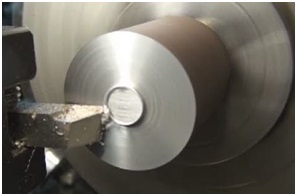
Facing operations are used to produce flat surfaces on the end of a part.
(2) Threading
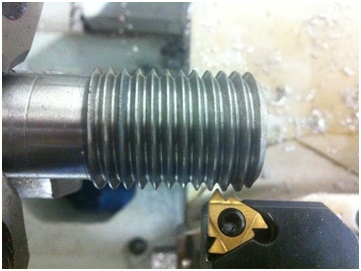
Threading operations produce external or internal threads on a part.
(3) Knurling
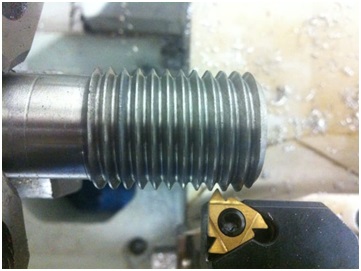
Knurling operations are used to produce a regularly shaped roughness on cylindrical surfaces.
(4) Drilling
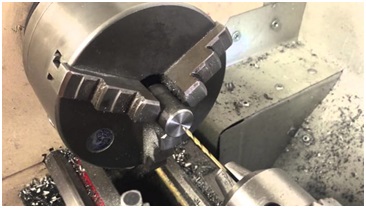
One of the most basic operations, drilling is used to generate holes in workpieces.
(5) Boring
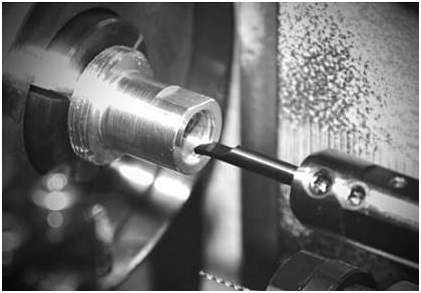
Boring involves enlarging a hole or cavity to produce circular, internal grooves.
(6) Reaming
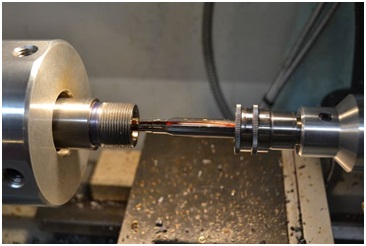
Reaming operations involve sizing and finishing existing holes.
(7) Taper Turning
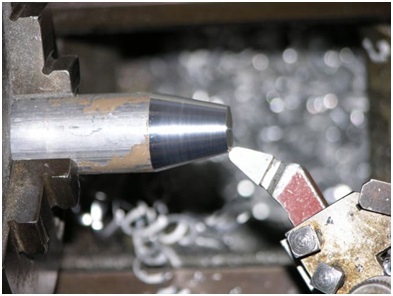
In taper turning, the diameter of the workpiece is gradually reduced over the length of the part.
4. Horizontal Turning vs. Vertical Turning
CNC turning centers come in either horizontal or vertical configurations. There are also inverted vertical turning centers, which reverse the position of the spindle and the chuck. All three machine types generally consist of the same basic components (i.e., headstock, carriage, etc.), but differ in their orientation. Deciding whether to opt for a horizontal, vertical or inverted vertical lathe depends on a host of factors, but there are some rules of thumb that can help you make the decision.
The advantage with a horizontal lathe is that gravity pulls the chips away from the part.
5. Turning Applications
CNC turning centers today are used in most metal cutting environments—whether it’s automotive, aerospace, agriculture,.
CNC Turning: Bottlenecks and Mistakes
In manufacturing, mistakes and bottlenecks in efficiency are to be avoided at all costs. This holds true even for a technology as old as the lathe, though the advent of computing in manufacturing has gone a long way toward minimizing these issues.
Bottlenecks for CNC Turning
One of the major limitations on lathe efficiency lies in the turning operation itself. This is not an issue that can be overcome with better tooling.
Machine tools are always trying to catch up to tooling capabilities. You might be able to cut at X amount of surface speed, but I can’t spin my chuck fast enough to generate that kind of surface speed. With turning, your rpm is limited because of chuck grip capabilities. The centrifugal force means that as the chuck is spinning around, the jaws want to move outward. On a machining center, the part is stationary and my tool—which is very compact—can be spun at 10, 12, 20 or even 40,000 rpm without big issues. There’s no way you can spin a chuck at 40,000 rpm; it would just come apart.
Another bottleneck for turning efficiency is one which applies to most manufacturing processes: changeover.
Deshengrui have rich experience in CNC turning service. Visit us more on www.desheng-precision.com


